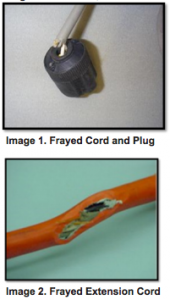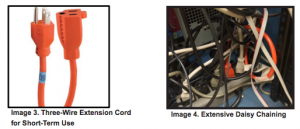This is the first of a multi-part series on the hazards posed with electrical equipment.
by: Nicole Campbell, Safety and Industrial Hygiene Specialist
Background
Laboratory workers may be exposed to electrical hazards including electric shock, electrocutions caused by short circuits and overloaded circuits and wiring. Most electrical-related incidents are caused by unsafe work practices or faulty equipment. Here, we cover two common issues with electrical cords: fraying of aging cords and the use of extension cords.
Frayed Cords
- Periodically, perform a visual inspection of all flexible cords for indications of possible damage (such as a pinched or crushed outer jacket). Images 1 and 2 exemplify this damage.
- Replace or repair damaged or defective electrical cords. Do not use electrical tape – or duct tape – to repair or protect worn, frayed or damaged flexible cords. Covering the damaged or worn areas of flexible cords with tape will prevent the user from conducting a proper visual inspection of the cord and can create a fire hazard if the cord overheats or sparks.
- Laboratory personnel should not attempt to repair defective electrical equipment or cords.
Extension Cords
- Three-wire extension cords should only be used for temporary and short-term use (Image 3). They are grounded with multiple layers of insulating materials and are designed for higher demand loads. Never use extension cords made with only two wires and no ground! These are designed to provide power to small current loads. • Never plug a surge protector or power strip into an existing surge protector or power strip (Image 4). This practice is known as “daisy chaining” and constitutes a fire hazard.
Have Some Questions?
- Refer to Emory University’s Electrical Safety Program at ehso.emory.edu or contact the Environmental Health and Safety Office at 404-727-5922.


Leave a Reply